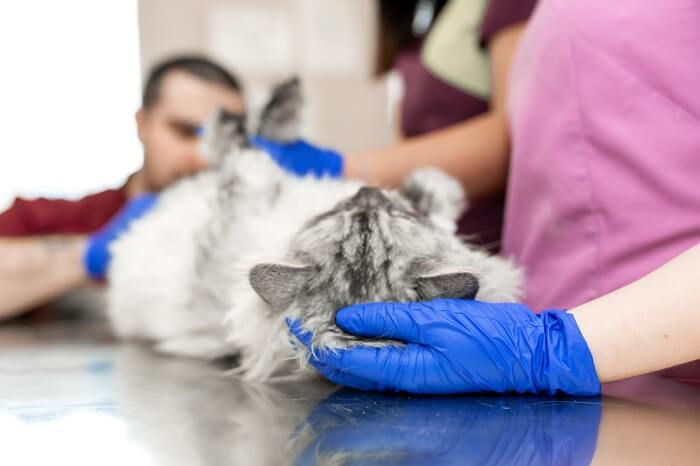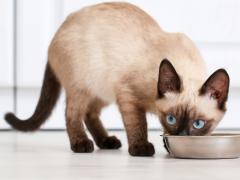
*Urethral obstruction in cats is life-threatening and requires emergency treatment. If your cat is having any difficulty urinating, get your cat treated right away to relieve the obstruction.
Have you heard of a “blocked cat?†No, this doesn’t describe a cat that loves to play with blocks.
A blocked cat suffers from urethral obstruction, a serious and life-threatening condition that is relatively common in cats.
There’s a lot to learn about urethral obstruction, so settle in and get comfortable. We’ll walk you through how urethral obstruction occurs and how it’s diagnosed, treated, and prevented.
Let’s get started!
What Is a Urethral Obstruction?
The urethra is part of the lower urinary tract, which is also composed of the urinary bladder and ureters (thin tubes connecting the kidneys to the bladder). The urethra is the tube that carries urine from the bladder to the outside of the body.
With a urethral obstruction, something is clogging up the urethra, preventing urine from exiting the body. An obstruction can be either partial or complete.
What Causes a Urethral Obstruction?
Urethral obstructions in cats have many causes. Regardless of the reason, the end result is that urine gets stuck and can’t get out.
Here is a list of common causes of urethral obstructions in cats:
- Urethral ‘plug’ of inflammatory material, including mucus, urinary stones, and urinary crystals
- Urethral spasms that narrow the diameter of the urethra
- Previous injury that scarred the urethra
- Lower urinary tract disease
- Cancer
Urethral obstructions are most common in young- to middle-aged male cats.
What Are the Risk Factors for Urethral Obstructions?

Urethral obstruction in cats is most common among male cats, with other risk factors including being overweight, living indoors, and eating a dry diet—among others.
Being a male cat is one of the most significant risk factors for a urethral obstruction. Why is that?
Well, it has to do with urethral anatomy. Male cats have a long and narrow urethra, increasing the likelihood of blockage. Female cats have shorter and wider urethras, so they are often spared the nightmare of urethral obstruction.
Here are other risk factors for urethral obstructions:
- Excessive weight
- Dry food diet
- Indoor-only cat
- Multi-cat household
- Behavioral issues: nervous, aggressive, fearful
- Lower urinary tract problems
What Are the Clinical Signs and Symptoms of a Urethral Obstruction?
Clinical signs of a urethral obstruction are not as evident as you might think. The initial clinical signs, listed below, primarily involve difficulty urinating. Cats can have trouble urinating for many reasons other than urethral obstruction, such as a urinary tract infection.
Initial clinical signs:
- Frequent trips to the litter box
- Peeing only in small amounts
- Bloody urine
- Vocalizing when urinating
- Licking the hind end
- Urinating outside of the litter box
As the obstruction inevitably gets worse, which can happen in as little as 24 hours, a blocked cat will become increasingly ill.
Why do cats become so ill, so quickly with a urethral obstruction? When urine can’t leave the body, toxins in the urine enter the bloodstream, causing a life-threatening condition called toxemia.
Also, urine that accumulates in the body causes imbalances in electrolytes, such as potassium. Electrolytes are minerals that help to maintain normal body functions.
Toxemia and electrolyte imbalances make blocked cats very sick. These poor kitties will develop systemic symptoms like the ones listed below:
- Decreased appetite
- Lethargy
- Vomiting
- Weakness
- Dull mentation
How Is a Urethral Obstruction Diagnosed?
Feline urethral obstructions are life-threatening, so a prompt diagnosis is necessary to start providing life-saving treatment. Delaying diagnosis and treatment for urethral obstruction can be fatal.
1. Physical Exam
A physical exam comes first. The veterinarian will feel the bladder, which will feel large and firm. The bladder will also be quite painful. The veterinarian will also try to empty the bladder gently. Emptying the bladder will be unsuccessful if there’s a urethral obstruction.
A male cat’s penis may be red from irritation due to constant licking. Sometimes, a urethral plug might be visible coming out of the penis.
The physical exam will also involve a close listen of the heart. A buildup of potassium in the blood (hyperkalemia) slows the heart rate and causes an abnormal heart rhythm.
Cats with a urethral obstruction may also be dehydrated. A dehydrated cat will have dry and sticky mucus membranes (such as the gums), and the skin will be less supple.
2. Diagnostic Testing
Physical exam findings provide a clear indication of urethral obstruction. However, diagnostic testing is necessary to determine what’s causing the obstruction and how sick a blocked cat is.
Bloodwork will reveal electrolyte imbalances and other abnormalities in the blood due to the toxemia. It will also indicate kidney function, which goes down because of urethral obstruction.
A urinalysis will help to identify blood and crystals in the urine.
X-rays of the abdomen provide a good view of the entire urinary tract and may reveal stones in the bladder.
How Is a Urethral Obstruction Treated?

Urethral obstruction in cats is an emergency and demands immediate treatment.
We can’t emphasize this enough: a urethral obstruction is an emergency!! A blocked cat must be hospitalized and treated right away.
1. Stabilization
Blocked cats that are severely ill need to be stabilized before the obstruction is relieved. Intravenous fluids are a mainstay of stabilizing treatment. It will help with rehydration and getting electrolyte levels back to normal. Other medications might be needed to correct electrolyte imbalances.
2. Cystocentesis
The bladder can become very distended with urethral obstruction. For blocked cats with extremely large bladders, a cystocentesis is performed to remove urine and help stabilize the patient. A cystocentesis will also help to relieve pressure on the bladder.
3. Urinary Catheter Placement
Once a cat is stable, the urethral obstruction must be relieved. Relieving the obstruction is done with the placement of a urinary catheter. Blocked cats are in a lot of pain, so sedation or anesthesia is required for catheterization.
The catheter is inserted through the penis and gently threaded up through the urethra. Ideally, the catheter can get past the obstruction and reach the bladder. If this isn’t possible, the veterinarian will use sterile fluid to flush the obstruction into the bladder.
Once the catheter is secured into place, the bladder is flushed and emptied with sterile fluid. The catheter will be kept in place for 24 to 72 hours. A urine collection bag may be attached to the end of the catheter to measure urine output after the obstruction is relieved.
If there are stones in the bladder that cannot be removed by flushing, the veterinarian will perform a cystotomy. During a cystotomy, the veterinarian surgically opens the bladder and removes the stones.
4. Medications
Blocked cats will often need medications while being treated for a urethral obstruction. Pain medications will help to reduce pain and inflammation. Medications to relax the urethra are also given.
During hospitalization, blocked cats are closely monitored to determine how well they’re responding to treatment.
What Happens After Treatment?

Following treatment, it’s important that your cat receives the appropriate care at home to ensure a healthy recovery.
Even after the obstruction is relieved, an affected cat cannot leave the hospital until they can urinate on their own, after the catheter is removed. Because the urethra may still be a little inflamed, urination might be difficult, and there might be blood in the urine.
At-home care is necessary to keep a cat comfortable, ensure that the treatment site fully heals, and reduce the chances of another blockage.
An e-collar prevents a cat from bothering the treatment site. Pelleted or paper litter is also recommended. Medications to relieve pain and relax the urethra are given for at least several days after hospitalization.
Many cats do well and fully recover after being treated for a urethral obstruction. However, cats with one obstruction are at risk of reobstruction, especially in the first week or two after treatment.
Several prevention measures lessen the chances of another obstruction:
- Feeding wet food
- Reducing stress
- Providing unlimited access to fresh water, such as with a circulating water bowl
- Feeding a prescription diet to prevent urinary crystal and stone formation
- Providing environmental enrichment, such as toys and cat perches
At-home care also involves watching for signs of systemic illness, such as lethargy and appetite loss. Cats that develop systemic signs after treatment need to be seen again right away.
What if My Cat Keeps on Getting Obstructions?
Some cats have the unfortunate luck of getting recurrent urethral obstructions, despite adequate treatment and prevention.
These cats need a last-resort treatment option to resolve the obstructions permanently. This treatment option is a surgical procedure called a perineal urethrostomy (PU). During a PU, the veterinarian removes a cat’s penis and creates another opening through which urine will exit the body.
Although a PU will resolve the obstruction, cats that undergo this surgery can still develop bladder stones and infections. Because of this, cats who have had this surgery have regular checks of their urine to look for signs of infection.
Frequently Asked Questions
How do you treat a cat with urethral blockage?
Urethral obstructions in cats require emergency treatment. Cats that are very ill from the obstruction need to be stabilized with intravenous fluid therapy and other medications before they receive further treatment.
After stabilization, a urinary catheter is placed to relieve the obstruction. This catheter is kept in place for several days. A cat must be able to urinate on its own before leaving the hospital.
How do I know if my cat has a urethral blockage?
A urethral blockage isn’t always obvious. A cat will show signs of having difficulty urinating: frequent trips to the litter box, urinating only small amounts at a time, and vocalizing during urination.
Can cats recover from urethral blockage?
Yes, but only if they receive emergency treatment right away. Cats with a urethral obstruction can become gravely ill within 24 hours, so immediate treatment is needed for the best chance of recovery.
What causes a blocked urethra in cats?
Anything that causes a physical blockage in the urethra can lead to urethral obstruction. These physical blockages can be caused by plugs of inflammatory material that’s composed of mucus, urinary stones, and urinary crystals. A cancerous mass can also block the urethra. Urethral spasms and lower urinary tract inflammation can lead to blocked urethras.







